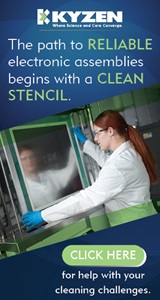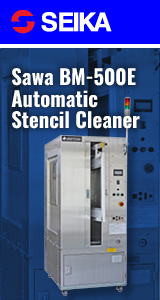|

|
|
| Ask the Experts | |||||||
|
|||||||
|
October 7, 2024 - Updated February 1, 2009 - Originally Posted Conformal Coating & HumidityCan conformal coating protect a circuit board that will be operating in a humid environment? We currently use a dip process to conformal coat our boards. However we're having problems with some circuit board assemblies due to condensation exposure. Is there a better process or conformal coating product that will keep this from happening? N. J. |
|||||||
| Expert Panel Responses | |||||||
|
In general a good conformal coating should be able to protect electronics in highly humid environments. Silicone excels in this due the hydrophobic behavior of the material that forms the final silicone coating. Silicones are difficult to wet by water. Silicone conformal coatings are being used in highly humid environments, with high efficiency and success, even when proven under high salinity and humidity conditions. For example a fridge will quickly condensate water that enters via moist air during the open-close door operation, a wash-machine board controller will face a highly humid environment with strong diluted ions in different temperature ranges, an in-the-cabin electronics should work perfectly OK even if the car is in a coastal, highly humid location for several years without a failure. All these applications have used silicone based conformal coatings. However, every different electronic application is different and should be analyzed individually. Is the board highly sensitive to moisture? Is the board trough-hole? Are several pins located nearby? What is the voltage on the application? These considerations impact directly the application. A board with 15ʼ000 volts on a TH board where the pins are 20 mils apart will be much more sensitive than a SMT board with low voltage. Does this means a coated board will perform underwater. Most likely no. While a conformal coating will prevent ionic corrosion over the board, a submerged board on an ionic solution will decrease the maximum voltage admissible in a certain gap that the same gap will have when normally filled by moist air. Once the material is selected the process is decided upon so as to get efficient wet out, limit contamination, and appropriate cure. Cleaning before coating is also required in most case to get adhesion. Adhesion is what allows the board to operate in a humid environment without failure.But cleaning is a question best answered by Kyzen.
President Krayden Inc. Wayne Wagner has over 25 years in the conformal coating industry and is the president of Krayden Inc., a leading distributor of engineered materials.
Conformal coatings are designed to protect electronic circuitry from a number of environments, including high humidity conditions. The level of protection provided will depend on the coating used, the application and also the cure schedule of the coating. You need to ensure that the coating you choose offers protection from humid environments; Electrolube's DCA and NVOC meet the requirements of many international standards for moisture resistance, for example. You then need to choose the correct application process for that coating. Dip coating should be fine however you need to ensure that the board is fully covered in the areas that need protecting. If there is any de-wetting of the coating it will leave parts exposed and hence cause failure. The coating should then be cured via the manufacturers' recommended schedule and if this is not practical you should ask for advice as there are usually a number of ways around this. Conformal coatings only provide a thin layer of protection, they will give some resistance to moisture in humid environments but they may struggle when water droplets remain on the surface. Therefore, orientation of the board should be considered. If the board is horizontal when in use and condensation occurs then the water may sit on the board for long periods of time. This could start to penetrate through the coating and cause failures. If the board is mounted vertically, the water can run off the coating surface. Either way, if there is a significant amount of water on the board you may want to consider encapsulation using a potting resin. These are less versatile than a thin coating but will offer greater protection in such environments.
European Technical Support Specialist Electrolube Ltd Jade Bridges is the European Technical Support Specialist for Electrolube. She is responsible for technical support within Europe, offering assistance to customers with product selection, implementation and after sales support across the range of Electrolube products. Her expertise is carried over from her position as R&D Manager for Electrolube, where she was responsible for the new product development and technical support across an array of chemical products for the electronics industry, including conformal coatings, encapsulation resins, thermal management products, contact lubrication and electronic cleaning solutions.
Conformal coating is one method of protecting a PCB from an end use environment. Conformal coatings are a thin layer of a dielectric material applied over the PCB. They are typically in the range of .002" to .010" depending on the chemistry and product. Certainly choosing the correct material for the end use environment is critical. From the question is may be that conformal coating that you are using may not be suitable for the end use environment. There are several major chemistry classes, urethane (UR), epoxy (ER), acrylic (AR), silicone (SR), and paraxylene (XY). After choosing the proper chemistry, then the process can be defined to apply that material. It may also be that conformal coating may not be the ideal PCB protection method. If the end use environment is harsh enough, then a more rigorous protection may be needed. Instead of conformal coating then you may need a potting material, a low pressure moulding material, or housing. These are methods that are used to protect electronic devices from different environments. Potting uses more material to encapsulate and protect the PCB; the most common chemistries used here are epoxy, urethane, and silicone. Low pressure moulding is a newer technology to electronics that uses polyamide materials to fully encapsulate the PCB utilizing a high through put rate process. A housing uses a physical case to protect the PCB, usually aluminium or plastic, and commonly uses an adhesive gasketing material to seal the enclosure. Proper definition of the end use environment and choosing the proper chemistry and method is critical to success of the device in the field.
Application Engineering Henkel Electronics Dr. Brian Toleno is the Application Engineering Team leader for Henkel Technologies. He is responsible for the technical service and application engineering for Henkel's electronics assembly materials, including solder paste, underfills, PCB protection materials, and underfills.
Are you using compliant pinning? If so spray directly onto the pads and let the pin cut into the plated through hole side walls. Conformal coating in my experience should help with your problem but I only have sprayed the application not dipped.
Applications Project Manager Quick Turn Flex Circuits LLC James Mahoney is a Technical Operations Manager with a 20 year track record in managing new product introduction. He is a skilled leader, motivator and problem solver with a strong background in Product Knowledge and Engineering Management.
There are several conformal coatings that are advertised as waterproof, search for MIL-SPEC conformal coatings and then you can sample them.
Regional Sales Manager OK International Inc. Ed Zamborsky is a Regional Sales & Technical Support Manager for Thermaltronics, located in New York. His position requires frequent customer visits throughout North America and the Caribbean and his position encompasses not only sales but the role of trainer and master applications engineer for all of Thermaltronics products. His expertise includes such specialties as hand soldering, convection and conduction reflow techniques, array rework, fluid dispensing equipment, and fume extraction. Ed has authored many articles and has presented many papers on topics such as; Low Volume SMT Assembly, Solder Fume Extraction, SMT Rework, BGA Rework, Lead-Free Hand Soldering, High Thermal Demand Hand Soldering, Lead Free Visual Inspection and Lead Free Array Rework.
If condensation due to high humidity is penetrating at only the interface(s) of your conformal coating and the board, you can increase the adhesion of the conformal coating to the board by using a suitable gas plasma treatment. The increased adhesion may be enough to keep the condensation out. This kind of plasma treatment is done to the entire surface of the board inside a low-pressure plasma system, just before your conformal coating step. Argon gas is a popular choice for this process, because it does not cause oxidation of the board material. The plasma treatment will activate the surface (increase the surface energy) of the board due to ion and free-radical interaction with the surface of the board, resulting in increased bondability to the conformal coating. However, if the condensation is actually penetrating the conformal coating itself, you may need to try a different type of conformal coating, one that is inherently less permeable to liquids. The problem with high-density conformal coatings is they're usually more difficult to bond to the board. As above, this kind of adhesion issue can be solved by using an appropriate gas plasma treatment. Gas plasma treatments are becoming increasingly popular for board manufacturing processes such as these. You can contact plasma system suppliers to see if they will run samples for you - most will do so at no charge in order to demonstrate the effectiveness of their gas plasma treatments.
Global Marketing Manager Nordson MARCH Mr. Szymanski works to expand strategic alliances, strengthen partnerships with equipment suppliers, and develop future product offerings tailored to the semiconductor market.
NOTE: Mr. Szymanski is no longer working at Nordson MARCH |
|||||||
| Submit A Comment | |||||||
|
Comments are reviewed prior to posting. You must include your full name to have your comments posted. We will not post your email address. |
|
Free Newsletter Subscription
Circuitnet is built for professionals who bear the responsibility of looking ahead, imagining the future, and preparing for it. Insert Your Email Address |
|

|








